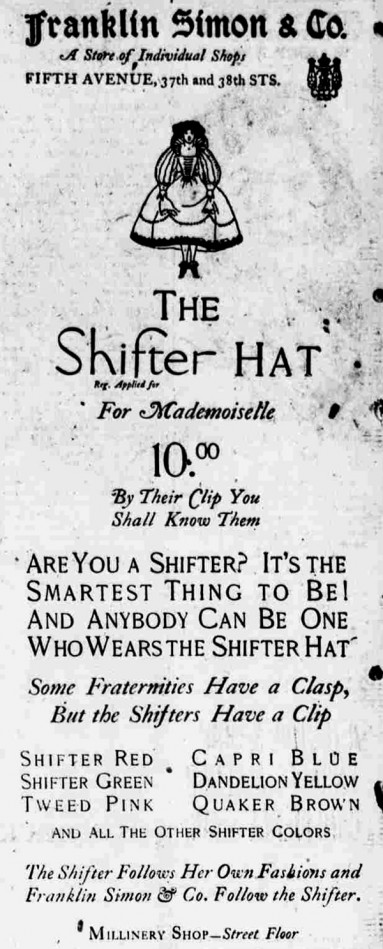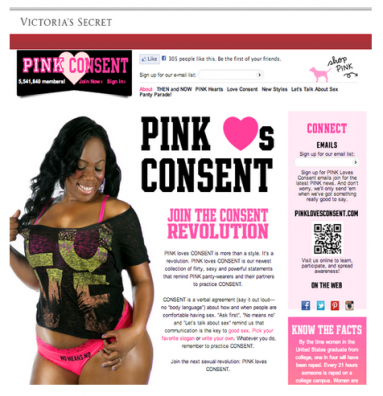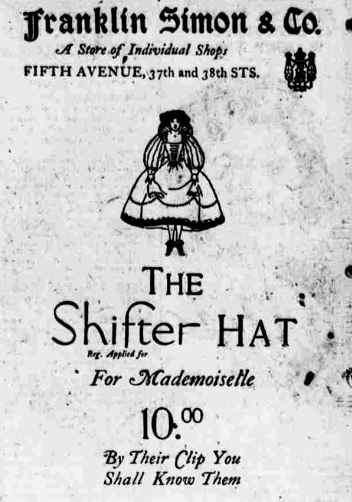What's going on in beauty this week, from head to toe and everything in between.

From Head...
Shifty stuff: You know about flappers, of course, but do you know about the Shifters, a subset of flapper that may or may not have had a Ponzi scheme going on? Either way, they had some serious fashion codes involving hats and paper clips: Two clips on the brim meant a Shifter was looking for a kiss, and so on.
...To Toe...
The idle woman's pedi: Are you really supposed to wait 24 hours after painting your toenails before wearing heeled boots?
...And Everything In Between:
Busy bodies: Fast Company
takes a business-end look at Procter & Gamble's strategies, and find the company comes up short. Case in point: the gazillion and a half Olay products on shelves, confusing the company's message. (Remember when it was just...Oil of Olay?)
Korea time: Even in the relatively short amount of time I've been paying attention to the global beauty industry, I've seen an enormous uptick in interest in Korea. This week, Korea is making
in-roads to the international market—this time, in Malaysia, and an American expat in Korea
shares her experience with "byzantine Korean standards of beauty." Plus, male "K-pop" stars in South Korea are
being tapped by cosmetics companies to endorse products; just as with Legos and beer, it turns out that using men in these ads attracts consumers of both sexes.
Persia style: The first-ever book surveying the history of clothing, jewelry, and cosmetics of Iran, going back 5,000 years.
Hotten-not: It's interesting to me that the central question around tennis pro Caroline Wozniacki's crude imitation of Serena Williams is whether it's racist, for
as Jessica Wakeman points out at The Frisky, regardless of whether it's racist (and there's, like, no argument to be made for it being seen as not racist), it's certainly hypersexualizing. And, ya know, just tacky.
Lab rats: I somewhat defended the
"Science: It's a Girl Thing" video from the European Commission when it came out—if the idea is to get more girls interested in science, you should probably speak to them in some sort of code that girls will understand is channeled directly to them, and like it or not, that's frequently the girly-girl stuff. Not ideal, but as one of a full arsenal of tactics, I'll take it. So it's no wonder that I'm missing the joke of
this spoof video released by a group of female scientists. Says one of the creators of the video, "We made the video mainly for fun, but also because the original was so awful. It was really demeaning to women, and contained no science at all—just make-up." So the group rebelliously went on to create a video that...contained no science at all—just makeup. It also contains plenty of humor, though, so I'll just chalk it up to that arsenal I mentioned?

Let's talk about sex: Feminist underwear prank! Who says we don't have a sense of humor? When a group of activists launched a fake Victoria's Secret underwear line stressing sexual consent (think "Ask First" panties), plenty of regular VS shoppers tweeted how thrilled they were to see the company take a stand on the matter. What would happen if a major company did produce this line?
Pucker up: What to do when
your partner doesn't like your makeup? (In my experience, lipstick is the biggest culprit here. I think dudes are afraid of sporting it themselves post-kiss, which seems like a fair complaint to register.)
Subjectified: This documentary
exploring young women's attitudes toward sex sounds riveting for a number of reasons, but the one that's relevant here is the way the film opens: The documentarian asks the subjects, "Are you beautiful?" I've asked this of a number of my own subjects, and believe me when I tell you that I will
never be able to predict what comes out of people's mouths. (via
Already Pretty)
"There's a profound ambiguity in the gaze of the Other": Is it possible to truly reinvent yourself, or are our identities so caught up in being both recognized and
misrecognized by others that reinvention is impossible?
Mr. Teacup muses on the question, using fashion as a lens—which makes sense, given how much we'd like to think fashion is about identity.
Clouds in my coffee: Kate's post on vanity is rife for exploration. As someone who has been called vain by commenters (not by
you, of course!), presumably because I write in the first person about my relationship with my looks, her refutation of the concept of vanity is intriguing. I'd also be interested in reading a
defense of vanity, though I'm not the one to write it. (Sarah Frye Valencius wrote a
related guest post for me last year; check it out.) Anyone?


